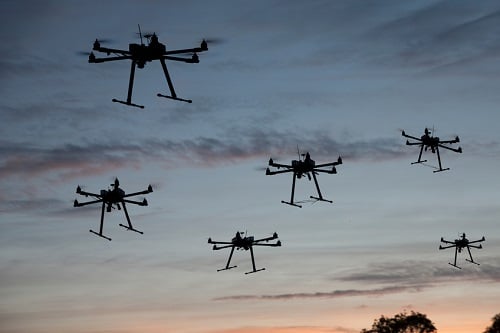The sale and use of drones, or unmanned aircraft systems [UAS], has skyrocketed in the last few years in both the recreational and commercial space. Though drones are now widely used across the globe, the US is the main driver of that growth; in March, the Federal Aviation Administration projected that the number of small hobbyist drones will surge to more than 3.5 million by 2021, and that the commercial drone fleet will explode to 442,000, compared to 42,000 at the end of last year.
Those numbers are even more staggering when compared to the active general aviation fleet in the US, which currently stands at around 204,000, says James Van Meter, aviation practice leader at
Allianz Global Corporate & Specialty.
“We’re talking about [unmanned] aircraft eclipsing – just completely outpacing, by huge factors – the manned aircraft space,” Van Meter says.
While there is huge demand in markets like Europe and Africa – where Van Meter believes there is growing potential for drones to help with humanitarian missions, anti-poaching and infrastructure inspection – the inconsistent regulatory landscape across the globe is often a hindrance. The US is largely setting the trend for drone usage, thanks to its active aviation market and comparatively lenient regulatory environment.
Many typically associate drones with the military, but the US commercial market is now using the aircraft across all kinds of industries, Van Meter says.
“We see all sorts of uses that you can’t even imagine – from delivering cocktails to wildlife control to industrial inspection,” he says. “We are insuring drones in almost every single industry at this point.”
Industry sectors with the highest drone usage include aerial photography – often for infrastructure inspection, especially in the energy and communications space – and construction, as well as media and production companies, says Chris Proudlove, senior vice president and manager of UAS risks at Global Aerospace.
“The one area that has been predicted as being the largest of all – agriculture – has been slower to adopt drones,” Proudlove says, adding that this is primarily due to the quality of the end product versus the relatively high cost. “This gap will narrow significantly in the coming years, and agriculture still stands to be one of the dominant user industries,” he says, pointing to the fact that many companies are now outsourcing drone services rather than developing their own in-house capabilities.
Accordingly, the insurance market for unmanned aircraft is expanding. “Insurers are keen to enter the sector, but the relatively low policy premiums and high administration costs are deterring many from entering,” Proudlove says.
As a result, most operators, manufacturers and others in the drone industry rely on aviation insurance for broad policies that will cover their exposures. However, more insurers are beginning to look at the technology and start developing products.
“It’s definitely gotten more competitive,” Van Meter says. “We do see standard, traditionally non-aviation markets getting into this space.”
In these cases, claims expertise can be a big issue, he adds.
“These are aircraft,” he says. “This is a special field with special regulations, and it has the potential for catastrophic losses – both severe bodily injury and fatalities. If you’re a corporate user of drones, do you really want to have a claims adjuster who isn’t an expert, adjusting what could be a significant claim with prolonged litigation?”
Having insured thousands of UAS, Allianz is now seeing claims trickle through.
“We’re insuring products and manufacturers who are manufacturing the aircraft and components; we’re also insuring software developers – so, we are seeing claims,” Van Meter says.
Insurance is increasingly becoming essential in the drone space – start-ups that may have previously been uninsured are securing contracts that require them to purchase insurance, sometimes at significant limits, while others are obtaining investment with the expectation that they are fully insured, Proudlove explains. “As the need for insurance develops, so will products and services to address those needs,” he says.
While annual policies are still the benchmark, some on-demand products, such as Verifly in the US, are starting to appear. Insurer appetite will also be driven by evolving drone technology, which is making things like collision avoidance, parachute systems and other safety devices the norm.
“Those sort of tech advances are going to continue to advance the overall industry and improve the losses that we are seeing,” Van Meter says. “The drone insurance market is absolutely going to continue to grow. This is probably one of the most explosive growth areas in aviation and in insurance in general.”


